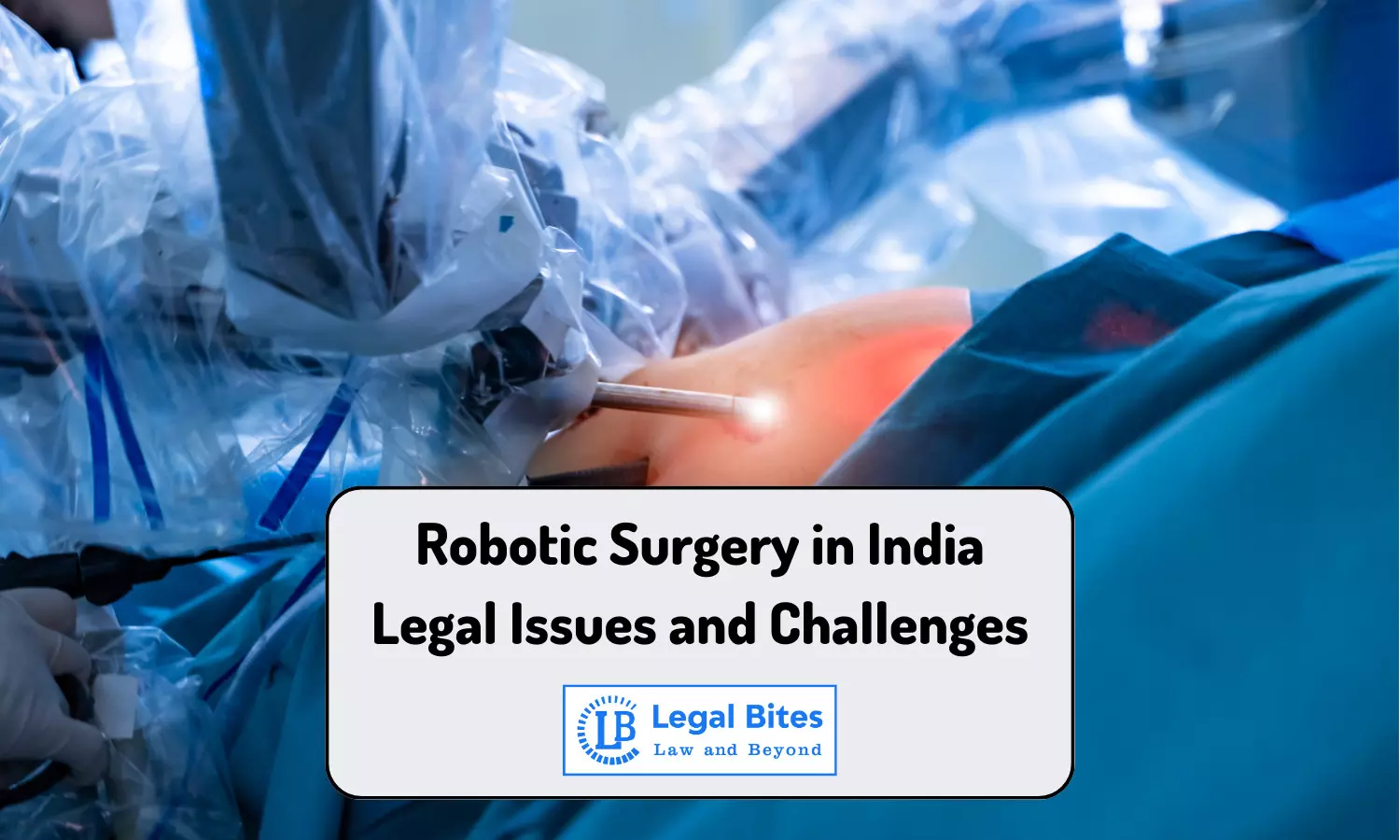Robotic Surgery in India: Legal Issues and Challenges
Stay abreast of the rapidly advancing landscape of medical technology, robotic surgery has emerged as a transformative tool in the field of healthcare.

Stay abreast of the rapidly advancing landscape of medical technology, robotic surgery has emerged as a transformative tool in the field of healthcare.
Robotic Surgery in India: Legal Issues and Challenges
Rapid scientific developments have become important in the healthcare sector worldwide. These scientific developments gave hospitals an edge over their competition. Cutting-edge technology such as AI and robotics-assisted surgery has enabled hospitals to specialize in accuracy, automation, and effective diagnosis with short-term treatment. The use of various means has improved the abilities of healthcare professionals and adapted to change more swiftly within the current prevalent scenario in the healthcare sector.
Conversely, scientific technology such as robotic tools demands a high degree of technical efficiency, a willingness to adapt to learning, and the capacity to accept challenges. Robotic technology in the healthcare sector raises new legal issues and challenges. The minds of doctors hold the promise of healthcare prosperity and development in the medical field; however, few also acknowledge that this capability hinges on the physical well-being of the patients. That is why a legal framework is needed, but that is evolving too slowly and clumsily.
This article will ponder how the use of robotic-assisted surgery has transformed traditional hospitals into smart hospitals in line with Digital India. Moreover, the article intends to explore the legal issues and challenges of robotically assisted surgery.
What is Robotic Surgery?
Technically, robotic surgery has not been defined exhaustively. Both the medical sciences and law are silent about the conceptual aspect. However, it may be referred to as a computerized program along with its arms that are regulated meticulously or rigorously by human beings, i.e., healthcare professionals. It is predominantly developed to lend assistance to surgeons during surgery.
Healthcare professionals aim to make the modus operandi more productive and simpler, especially in intricate surgeries. Indeed, the technology is not deliberated to act single-handedly or to substitute for healthcare professionals. Rather, these robots function as hands-on enlargements of the surgeon impelled and powered exclusively by their expertise or standard of care as required by law.
Overall, we need to evolve the conceptual model of robotic surgery so that those who are responsible for managing legal affairs can create an effective legal framework.
What is the scale of robotic-assisted surgery in India?
AI and robotic-assisted surgery represent the pinnacle of astonishing scientific development. The US FDA granted a nod to the Da Vinci system, an innovative technology for urological robot surgery, in 2000. Acknowledging the efficacy of the technology, AIIMS (New Delhi) amalgamated the technique into surgical practice, and therefore, India became the first Asian country to grant formal approval. Subsequently, the growth of robotic surgery has shown propitious outcomes in India. It should pat itself on the back for the anomalous count of 66 newfangled robotic surgery centres at present.
There were a total of 71 robotic installations till July 2019. For robotic-assisted surgery, more than 500 of the country's most dexterous surgeons have been professionally mastered to facilitate the medical practice to enhance proficiency in operations. In India, over the past 12 years, an incredulous 12,800 operations have been effectuated using these contemporary techniques.
What are the Benefits of Robotic-Assisted Surgery?
a) Accessible at Remote Locations: Those with fewer means can take advantage of robotic technology by providing it in government hospitals, which allows surgeons to do operations at a remote location with the help of such technology. Healthcare opportunities tend to be limited in certain regions due to geographical barriers and a lack of infrastructure facilities.
b) Can Reduce Health Complications: The technology seems to become more and more indispensable as overall health complications could be reduced remarkably.
c) Reduction of time and Augmentation of skills: The application of robotic technology may augment the skills of surgeons and reduce the time required for executing traditional surgical procedures. It allows them to augment their credibility and prove their performance, which would enhance the application of AI in future medical diagnoses.
d) Reduce Blood Loss and Pain: It offers a remarkable opportunity to minimize post-operative pain and discomfort, drastically diminishing the likelihood of blood loss and the necessity for transfusions.
What are the Legal Issues and Challenges in India?
a) Lack of Comprehensive Regulations: Among the predominant concerns surrounding robotic-assisted surgery is the lack of compendious regulations. The Code of Medical Ethics Regulations, 2002, does not unequivocally prohibit the application of robotic technology but makes it mandatory for doctors to reveal the use of such technology to patients.
In addition, specific details covering superintendence and grasping the application of robotics in surgical operations have not yet been published by the National Medical Commission (NMC). Additionally, the Drugs and Cosmetics Act,1940 includes a broad range of medical devices, such as software intended to be used for medical devices within the scope of the term "drugs.” It also ensures high standards of quality, safety, and efficiency in the registration, importation, and sale of medical devices.
Additionally, in line with the evolving landscape of scientific technology, the Medical Devices Rules of 2017 have acted as a ray of hope for providing a contemporary framework for the regulation of medical devices, including robotic surgical systems. However, a bare reading reveals that the regulations are laconic.
The standards for the manufacture, importation, clinical investigation, and monitoring of the market for such devices are recapitulated in these rules. However, a relook at the existing framework unveils how the issue of a lack of comprehensive regulations remains unheeded. A probability, therefore, exists for potential misuse of technology in the future.
b) Issue of Informed Consent: Issue of Informed Consent: Obtaining free informed consent from patients plays a pivotal role in every surgical procedure. Nevertheless, when it comes to robotic-assisted surgery, the dynamics become further convoluted since patients need to be explicitly informed about its use in their operation.
Furthermore, discerning liability in instances of adverse events or complications becomes intricate when a robot is part of the equation. In the significant judgment of Samira Kohli v. Prabha Manchanda, AIR 2008 SC 138, the Supreme Court of India delivered a significant verdict affirming that medical practitioners must reveal every pertinent detail to their patients. Such precedents assume great significance in the context of robotic surgeries, shedding light on the paramount significance of acquiring legitimate consent.
c) Medical Misconduct: The Indian Medical Council (Professional Conduct, Etiquette, and Ethics) Regulations, 2002, generally supervised medical misconduct. The Indian Medical Council (Professional Conduct, Etiquette, and Ethics) Regulations, 2002, generally supervised medical misconduct. These regulations perspicuously define the expected professional conduct for registered healthcare professionals, including those who perform robotic-assisted surgeries.
The regulations give top priority to patient safety along with adherence to established standards of care as required by law. One notable case is Jacob Mathew v. State of Punjab, (2005) 6 SCC 1, wherein the apex court highlighted the importance of apropos skills and judicious care through legitimate procedures. Overall, the precedent set a benchmark for cases about robotic surgery, underpinning the significance of competence, diligence, and adherence to procedures established by law.
d) Medical Negligence and Liability: Currently, there is no comprehensive statutory enactment about medical negligence and liability. The Consumer Protection Act of 2019 is vital legislation on this subject and provides a way for patients to be compensated for either medical injuries or damages. In addition, the Act also provides the product liability.
Apart from this, Indian Penal Code 1860, can also be put into effect, especially Section 304A which deals with death caused by negligence. This legal provision addresses criminal culpability. In addition to this, the apex court in Malay Kumar Ganguly v. Dr Sukumar Mukherjee & Ors., AIR 2010 SC 1162, emphasized that doctors are under a legal obligation to exercise prudent conduct during surgical procedures.
e) Data Protection and Privacy: The Digital Personal Data Protection Act, 2023 is an effective legislation. In other words, it has been a major turning point in the context of data protection and privacy. The primary aim of the legislation is to regulate the collection and processing of digital personal data lawfully. Data is defined as
“a representation of information, facts, concepts, opinions or instructions in a manner suitable for communication, interpretation or processing by human beings or by automated means."
However, the Act has failed to make a distinction between fundamental expressions, i.e., sensitive personal data and personal data. Moreover, by the IT Act, 2002 (along with the IT (reasonable security practices and procedures and sensitive personal data or information) Rules, 2011.), any personal data accumulated during the surgery shall be deemed to be sensitive personal data and therefore necessitate meticulous handling. Unfortunately, when it comes to addressing the specific sensitive personal data of individuals, this creates a lacuna in the legislation, which, if left unaddressed, could conceivably leave individuals more vulnerable to privacy infringements.
What are the Possible Solutions?
It seems that robotic-assisted surgery is in desperate need of assistance from a legal perspective so that researchers can evolve out of the chart legal framework, in particular with liability, safety, and data protection issues, and thus must be amenable to the overtures of the government. The notable recommendations are:
- First, it is essential to chalk out a comprehensive regulatory framework specifically designed for robotic surgery.
- Secondly, the issue of negligence and liability can be addressed through effective implementation by providing standardized training.
- Thirdly, the ambit of insurance coverage should be effectively extended to them. It is hoped that the government will come forward with a productive framework.
References
[1] Girdhar Singh Bora, Tushar Aditya Narain, et al., Robot-assisted surgery in India: A SWOT Analysis, Available Here
[2] Kavita Kishore, The Manifold Possibilities of Robotic Surgery, Available Here
[3] Niyai Deo and Ashish Anjankar, Artificial Intelligence with Robotics in Healthcare: A Narrative Review of Its Viability in India, Available Here
[4] Satvik N Pai, Madhan Jeyaraman, et. al., In the Hands of a Robot, From the Operating Room to the Courtroom: The Medicolegal Considerations of Robotic Surgery, Available Here

